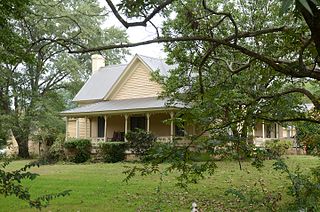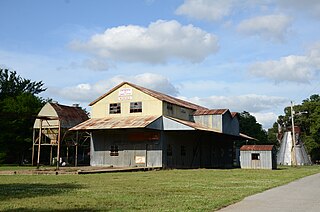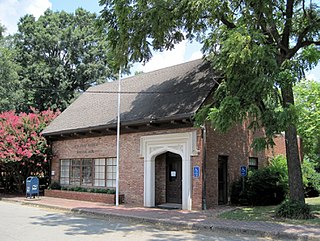
The Jarrell Plantation State Historic Site is a cotton plantation and state park in Juliette, Georgia, United States. Located in the red clay hills of the Georgia piedmont, the site stands as one of the best-preserved examples of a "middle class" Southern plantation. The Jarrell Plantation's buildings and artifacts all came from one source, the Jarrell family, who farmed the land for over 140 years. It was added to the National Register of Historic Places in 1973. It is a Georgia state park in Jones County.

John Blue House in Laurinburg, North Carolina was built in 1895. It was listed on the National Register of Historic Places (NRHP) in 1978.

Indian Bay is an unincorporated community in southern Monroe County, Arkansas, United States, in the Arkansas Delta. Indian Bay is on the eastern bank of the White River, 4 miles (6.4 km) east of St. Charles. For purposes of the U.S. Census, Indian Bay is within Montgomery-Smalley Township. The Baytown Site, a Pre-Columbian Native American archaeological site, is located near Indian Bay.

Judd Hill is an unincorporated community in Poinsett County, Arkansas, United States. Judd Hill is located on Arkansas Highway 214, 5 miles (8.0 km) south of Trumann. The Judd Hill Cotton Gin, which is listed on the National Register of Historic Places, is located in Judd Hill. Judd Hill was named for banker and businessman Orange Judd Hill, who founded the community.

The Judd Hill Cotton Gin is a historic cotton gin in Judd Hill, Arkansas. The gin was part of the Judd Hill Plantation, which was established by businessman Orange Judd Hill in the 1920s and sold to Hill's daughter and her husband, Esther and Samuel Chapin, in 1933. The cotton gin was built on the plantation circa 1930; its brick construction, designed to prevent fires, makes it a rarity among extant cotton gins. The plantation was successful throughout the 1940s and became one of the largest farms in Poinsett County. The cotton gin ceased operations in the 1970s or 1980s, but the plantation is still operated by the Judd Hill Foundation established by Esther Chapin. On September 28, 2005, the cotton gin was added to the National Register of Historic Places.

The Kemp Cotton Gin Historic District encompasses the only cotton gin extant in the Rohwer area of Desha County, Arkansas. The gin was built in 1950 by O. O. Kemp, a few years after the closure of the Rohwer War Relocation Center, where as many as 10,000 Japanese-Americans were interned during the Second World War. After the center's closure much of its land was returned to agricultural use, and Kemp built this gin near the Missouri Pacific Railroad line that ran through Rohwer. In addition to the gin, the complex Kemp built includes a pump house, scale house, and office. This entire complex was listed on the National Register of Historic Places in 2005.

Browntown is a national historic district located near Johnsonville, Florence County, South Carolina. The district encompasses 7 contributing buildings and 4 contributing structures reflecting the self-sufficient way of life practiced by several generations of the Brown family during the 19th and early-20th centuries. Moses Brown and his son and grandsons were self-sufficient farmers who operated their own brick kiln, grist mill, lumber mill, cotton gin, retail and wholesale mercantile business, and school. The property nominated includes the cotton gin building, three residences, the school, a tobacco barn, and several outbuildings. Browntown includes examples of both log and frame construction, and are grouped in two complexes, one group adjacent to the road and the other across the fields around the cotton gin building.

Lancaster Cotton Oil Company is a historic factory complex and national historic district located at Lancaster, Lancaster County, South Carolina. It encompasses five contributing buildings and six contributing structures associated with the Lancaster Cotton Oil Company established in 1907. The Lancaster Cotton Oil Company office and seed house burned in 1913 and were replaced as the company continued to grow. After the post-World War I decline the Lancaster and Kershaw cotton oil mills were among South Carolina's larger and more centrally located mills which survived into the 1930s and 1940s. Contributing resources include the Seed and Hull House (1937), Cotton Seed Processing Plant (1907), Oil Storage Tanks and Shed (1907), Cotton Gin (1907), and an office (1907).

Highland Park Manufacturing Plant and Cotton Oil Complex is a historic industrial complex and national historic district located at Rock Hill, South Carolina. It encompasses three contributing building and two contributing structures in Rock Hill. The complex includes the Highland Park Manufacturing Plant, the Highland Park Cotton Oil Mill (1902), and the Highland Park Cotton Oil Mill Office (1902). They are the surviving buildings of a larger complex, including a gin and seed house, the rest of which have been demolished. Surrounding the original mill are portions of the mill village. The mill operated until 1968.

The Goodlett Gin is a historic cotton gin in Historic Washington State Park in Hempstead County, Arkansas. It was built in 1883 by David Goodlett, and was originally located near Ozan before it was moved to the state park in the late 1970s. It is the only known operational steam gin in the United States. It was fitted with a steam engine in 1898, and received major servicing in the 1930s and 1950s.

The Womack–Parker House is a historic house off Arkansas Highway 4 in Nashville, Arkansas. The house is notable for its age, its association with one of Nashville's leading businessmen, and for its distinctive architecture. The house is a single block of wood frame construction with a central hall plan. It has porches with decorative jigsaw woodwork on three sides. Its construction date is uncertain, but it was purchased in 1878 by David Womack and extensively altered. Womack arrived in Howard County in 1849, and operated a highly successful array of businesses, including a lumber mill, and a cotton gin. The property on which the house stands also includes a variety of 19th-century log structures.

The John H. Johnston Cotton Gin Historic District encompasses a historic cotton gin in the small community of Levesque, Arkansas. The main building of the gin was built in 1941, and was built out of reinforced concrete, instead of the more usual steel, owing to a metal shortage in World War II. It has some Moderne styling, with smooth surfaces and rounded corners. The gin also distinctively incorporates a seed storage facility at its rear. Its ancillary structures, which include a shed, privy, and cyclone structure, are wood-framed with metal siding and roofing.

The Wynne Wholesale Commercial Historic District encompasses a small collection of historic commercial properties in Wynne, Arkansas. It extends for two blocks along West Merriman Avenue, west of Martin Luther King Jr. Boulevard, and includes four historic buildings: the Wynne Municipal Water Works, the Wynne Wholesale Grocer Company building, the R. J. Jackson Gin Company's cotton gin, and the Sharp Floral Building. A fifth building, the Wynne Ice & Coal Company's ice house, also stands in the district, but has been recently modified. These building are representative of wholesale business activities that took place in Wynne in the first half of the 20th century.
The Piggott Commercial Historic District encompasses the original center of the city of Piggott, Arkansas, as originally platted out in 1887. It is centered on the square where the Clay County courthouse is located, buildings facing the courthouse square, and also buildings along some of the adjacent streets. In addition to the courthouse, the district includes the c. 1910 railroad depot, city hall, two churches, the 1930s Post Office building, a cotton gin, and a grain storage yard. The town grew because of the railroad, and the plentiful timber in the area, whose harvesting fueled the early economy in the region. The oldest building in the district is the 1897 Clay County Bank at 188 West Main Street.

The Weldon Gin Company Historic District encompasses a historic cotton gin complex in Weldon, Arkansas. With a history dating to 1833, the Weldon Gin Company was long a staple of the local economy. Located in the center of the town at the junction of Weldon and Washington Streets, the company complex includes a main gin building, built in 1939, and four outbuildings. The present mill was built to replace an earlier steam-powered mill after electricity was introduced to the area in the 1930s.

The Hanger Cotton Gin is a historic cotton gin in Sweet Home, Arkansas. Built about 1876, it is a rare surviving example of a steam-powered gin. The main building is a three-story frame structure covered in board-and-batten siding. The gin was only operated commercially for a brief period, and was out of service by 1892. Since then, the building has been used as a barn and grain storage facility. It was probably built by Peter Hanger, whose family has been prominent in the Little Rock business community since that time.

The Floyd Cotton Gin is a historic cotton gin at the junction of Arkansas Highway 31 and Arkansas Highway 305 in Floyd, Arkansas. It is a two-story wood frame building roughly L-shaped with a single-story section extending its southern end and a two-story section projecting east under a continuation of the sloping gabled roof. This gin was built in the 1930s, when White County was one of the nation's leading producers of cotton. It is one of five gins in the county to survive from that period.

The Keo Commercial Historic District encompasses a cluster of commercial and industrial buildings that make up the economic center of the small city of Keo, Arkansas. The district includes a two-block section of Main Street, anchored at its southern end by the Cobb Cotton Gin complex, and on the north by Arkansas Highway 232, where it extends a short way in both directions. The community grew around the Cotten Belt Railroad line, which Main Street was laid out just west of. The cotton gin complex has its origins in 1906, as a means for local farmers to process their cotton and send it on to market via the railroad.

The Walker Homestead Historic District encompasses a collection of related agricultural and homesteading properties in rural White County, Arkansas. Located on Gum Spring Road about 1 mile (1.6 km) east of Arkansas Highway 267 southwest of Searcy, the district includes two farmstead houses, a barn, tenant housing, cotton gin, and other features. The oldest portion of the oldest house is a single pen log structure built about 1850 by William Walker, one of the area's early settlers, while the other house is a c. 1900 vernacular Greek Revival structure built by Billy Walker, Sr. The district encapsulates a typical evolutionary history of rural properties in the region, and was listed on the National Register of Historic Places in 1992.

The Willson Commercial Historic District encompasses the commercial and industrial heart of Wilson, Arkansas. Founded in 1886 as a company town by Robert Edward Lee Wilson, the city's growth was regulated and planned by the company until it was formally incorporated in 1950. This district encompasses the historic town square, commercial buildings, and the administrative and industrial buildings of the company's cotton gin and flour mill.

























